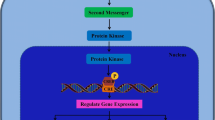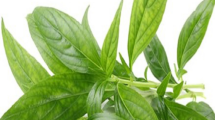Abstract
Associated with the aging of our world population is a sharp increase in the incidence of Alzheimer’s disease, which not only poses a significant health issue but also presents a serious social problem. Although pharmacological treatments were developed based on existing hypotheses, the disease pathogenesis remains to be fully elucidated. Given the complexity of Alzheimer’s disease, Chinese herbal medicine appears to have therapeutic potential for Alzheimer’s disease through multi-target and multi-pathway approach at cellular and molecular levels and holistic adjustment of the body at organ system levels. Recently, a significant breakthrough has been made in the research of Chinese medicine for Alzheimer’s disease. In this article, we review the experimental research progress in understanding how Chinese medicine could be used for the treatment of Alzheimer’s disease.
Similar content being viewed by others

References
Berchtold NC, Cotman CW. Evolution in the conceptualization of dementia and Alzheimer’s disease: Greco-Roman Period to the 1960s. Neurobiol Aging 1998;19:173–189.
Brookmeyer R, Gray S, Kawas C. Project ions of Alzheimer’s disease in the United States and the public health impact of delaying disease onset. Am J Public Health 1998;88:1337–1342.
World Health Organization. Neurological disorders: public health challenges. Switzerland: World Health Organization; 2006:204–207.
Scarpini E, Scheltens P, Feldman H. Treatment of Alzheimer’s disease: current status and new perspectives. Lancet Neurol 2003;2:539–547.
Parihar MS, Hemnani T. Alzheimer’s disease pathogenesis and therapeutic interventions. J Clin Neurosci 2004;11:456–467.
Huang Y, Mucke L. Alzheimer mechanisms and therapeutic strategies. Cell 2012;148:1204–1222.
Silva DF, Esteves AR, Oliveira CR, Cardoso SM. Mitochondria: the common upstream driver of amyloid-beta and tau pathology in Alzheimer’s disease. Curr Alzheimer Res 2011;8:563–572.
Zhong SZ, Ma SP, Hong ZY, Jin XM. Anti-inflammation effect of Danggui Shaoyao San on Alzheimer’s diseases. China J Chin Mater Med (Chin) 2011;36:3155–3160.
Wang R, Yan H, Tang XC. Progress in studies of huperzine A, a natural cholinesterase inhibitor from Chinese herbal medicine. Acta Pharmacol Sin 2006;27:1–26.
Tang LL, Wang R, Tang XC. Effects of huperzine A on secretion of nerve growth factor in cultured rat cortical astrocytes and neurite outgrowth in rat PC12 cells. Acta Pharmacol Sin 2005;26:673–678.
Zhang HY, Yan H, Tang XC. Huperzine A enhances the level of secretory amyloid precursor protein and protein kinase C-alpha in intracerebroventricular beta-amyloid-(1–40) infused rats and human embryonic kidney 293 Swedish mutant cells. Neurosci Lett 2004;360:21–24.
Yan H, Zhang HY, Tang XC. Involvement of M1-muscarinic acetylcholine receptors, protein kinase C and mitogenactivated protein kinase in the effect of huperzine A on secretory amyloid precursor protein-alpha. Neuroreport 2007;18:689–692.
Wang J, Zhang HY, Tang XC. Huperzine A improves chronic inflammation and cognitive decline in rats with cerebral hypoperfusion. J Neurosci Res 2010;88:807–805.
Wang C, Yan Z, Wang W, Xie T, Wang JW, Zhao SL, et al. Huperzine A activates Wnt/β-catenin signaling and enhances the nonamyloidogenic pathway in an Alzheimer transgenic mouse model. Neuropsychopharmacology 2011;36:1073–1089.
Yang L, Ye CY, Huang XT, Tang XC, Zhang HY. Decreased accumulation of subcellular amyloid-beta with improved mitochondrial function mediates the neuroprotective effect of huperzine A. J Alzheimers Dis 2012;31:131–142.
Zheng CY, Zhang HY, Tang XC. Huperzine A attenuates mitochondrial dysfunction after middle cerebral artery occlusion in rats. J Neurosci Res 2008;86:2432–2440.
Fang F, Chen X, Huang T, Lue LF, Luddy JS, Yan SS. Multi-faced neuroprotective effects of Ginsenoside Rg1 in an Alzheimer mouse model. Biochim Biophys Acta 2012;1822:286–292.
Li W, Chu Y, Zhang L, Yin L, Li L. Ginsenoside Rg1 attenuates tau phosphorylation in SK-N-SH induced by Aβ-stimulated THP-1 supernatant and the involvement of p38 pathway activation. Life Sci 2012;91:809–815.
Wu JY, Shen YY, Zhu WJ, Chen MY, Wang ZQ, Liu Y, et al. Ginsenoside Rg1 antagonizes β-amyloid peptideinduced apoptosis in primarily cultured rat neurons via mitochondrial pathway. J Zhejiang Med Univ (Med Sci, Chin) 2012;41:393–401.
Tohda C, Matsumoto N, Zou K, Meselhy MR, Komatsu K. Abeta (25–35)-induced memory impairment, axonal atrophy, and synaptic loss are ameliorated by M1, a metabolite of protopanaxadiol-type saponins. Neuropsychopharmacology 2004;29:860–868.
Wei CB, Jia JP, Wang F, Jia LF. Protective effects of ginsenoside Rg1, Rb1 on cultured CHO cells injure induced by β-amyloid protein (Aβ 25–35). China J Tradit Chin Med Pharm (Chin) 2008;23:616–618.
Chen F, Eckman EA, Eckman CB. Reductions in levels of the Alzheimer’s amyloid beta peptide after oral administration of ginsenosides. Faseb J 2006;20:1269–1271.
Shi J, Xue W, Zhao WJ, Li KX. Pharmacokinetics and dopamine/acetylcholine releasing effects of ginsenoside Re in hippocampus and mPFC of freely moving rats. Acta Pharmacol Sin 2013;34:214–220.
Li N, Liu B, Dluzen DE, Jin Y. Protective effects of ginsenoside Rg2 against glutamate-induced neurotoxieity in PC12 cells. J Ethnopharmacol 2007;111:458–463.
Wang YZ, Zhang JT. Cognitive function and neural plasticity-the basic mechanism of improving cognitive function of ginsenoside Rg1 due to its regulation for neural plasticity. Herald Med (Chin) 2007;26:702–708.
Benishin CG, Lee R, Wang LC, Liu HJ. Effects of ginsenoside Rb1 on central cholinergic metabolism. Pharmacology 1991;42:223–229
Chen Q, Cao YG, Zhang CH. Effect of Tenuigenin on cholinergic decline induced by amyloid peptide and ibotenic acid in rats. Acta Pharm Sin 2002;37:913–917.
Chen Y, Huang X, Chen W, Wang N, Li L. Tenuigenin promotes proliferation and differentiation of hippocampal neural stem cells. Neurochem Res 2012;37:771–777.
Chen Q, Li LK. Protective effect of tenuigenin on cytotoxicity of primary cultures of cortical neurons induced by amyloid beta-protein 1–40 (Abeta(1–40)). China J Chin Mater Med (Chin) 2007;32:1336–1339.
Jia H, Jiang Y, Ruan Y, Zhang Y, Ma X, Zhang J, et al. Tenuigenin treatment decreases secretion of the Alzheimer’s disease amyloid protein in cultured cells. Neurosci Lett 2004;367:123–128.
Wei G, Yunbo C, Chen DF, Lai XP, Liu DH, Deng RD, et al. β-Asarone inhibits neuronal apoptosis via the CaMK II/CREB/Bcl-2 signaling pathway in an in vitro model and AβPP/PS1 mice. J Alzheimers Dis 2013;33:863–880.
Zhang H, Han T, Yu CH, Rahman K, Qin LP, Peng C. Ameliorating effects of essential oil from Acori graminei rhizoma on learning and memory in aged rats and mice. J Pharm Pharmacol 2007;59:301–309.
Limón ID, Mendieta L, Díaz A, Chamorro G, Espinosa B, Zenteno E, et al. Neuroprotective effect of alpha-asarone on spatial memory and nitric oxide levels in rats injected with amyloid-beta (25–35). Neurosci Lett 2009;453:98–103.
Lim GP, Chu T, Yang F, Beech W, Frautschy SA, Cole GM. The curry spice curcumin reduces oxidative damage and amyloid pathology in an Alzheimer transgenic mouse. J Neurosci 2001;21:8370–8377.
Greene LA, Tischler AS. Establishment of a noradrenergic clonal line of rat adrenal pheochromocytoma cells which respond to nerve growth factor. Proc Natl Acad Sci 1976;73:2424–2428
Zhang L, Fiala M, Cashman J, Sayre J, Espinosa A, Mahanian M, et al. Curcuminoids enhance amyloid-beta uptake by macrophages of Alzheimerps disease patients. J Alzheimers Dis 2006;10:1–7.
Liu T, Jin H, Sun QR, Xu JH, Hu HT. Neuroprotective effects of emodin in rat cortical neurons against beta-amyloidinduced neurotoxicity. Brain Res 2010;1347:149–160.
Masaki H, Sakaki S, Atsumi T, Sakurai H. Active-oxygen scavenging activity of plant extracts. Biol Pharm Bull 1995;18:162–166.
Pase MP, Kean J, Sarris J, Neale C, Scholey AB, Stough C. The cognitive-enhancing effects of Bacopa monnieri: a systematic review of randomized, controlled human clinical trials. J Altern Complement Med 2012;18:647–652.
Song Y, Qu R, Zhu S, Zhang R, Ma S. Rhynchophylline attenuates LPS-induced pro-inflammatory responses through down-regulation of MAPK/NF-κB signaling pathways in primary microglia. Phytother Res 2012;26:1528–1533.
Xian YF, Lin ZX, Mao QQ, Hu Z, Zhao M, Che CT, et al. Bioassay-guided isolation of neuroprotective compounds from Uncaria rhynchophylla against beta-amyloid-induced neurotoxicity. Evid Based Complement Altern Med 2012 June 20 [Epub ahead of print]
Xian YF, Lin ZX, Mao QQ, Ip SP, Su ZR, Lai XP. Protective effect of isorhynchophylline against β-amyloidinduced neurotoxicity in PC12 cells. Cell Mol Neurobiol 2012;32:353–360.
Russo P, Frustaci A, Fini M, Cesario A. From traditional European medicine to discovery of new drug candidates for the treatment of dementia and Alzheimer’s disease: acetylcholinesterase inhibitors. Curr Med Chem 2012 Dec 3 [Epub ahead of print]
Durairajan SS, Liu LF, Lu JH, Chen LL, Yuan Q, Chung SK, et al. Berberine ameliorates β-amyloid pathology, gliosis, and cognitive impairment in an Alzheimer’s disease transgenic mouse model. Neurobiol Aging 2012;33:2903–2919.
Lan Z, Liu J, Chen L, Fu Q, Luo J, Qu R, et al. Danggui Shaoyao San ameliorates cognition deficits and attenuates oxidative stress-related neuronal apoptosis in D-galactose-induced senescent mice. J Ethnopharmacol 2012;141:386–395.
Zhong S, Ma S, Hong Z, Jin X. Anti-inflammation effect of Danggui Shaoyao San on Alzheimer’s diseases. China J Chin Mater Med (Chin) 2011;36:3155–3160.
Qian YF, Wang H, Yao WB, Gao XD. Aqueous extract of the Chinese medicine, Danggui Shaoyao San, inhibits apoptosis in hydrogen peroxide-induced PC12 cells by preventing cytochrome c release and inactivating of caspase cascade. Cell Biol Int 2008;32:304–311.
Kou J, Zhu D, Yan Y. Neuroprotective effects of the aqueous extract of the Chinese medicine Danggui Shaoyao San on aged mice. J Ethnopharmacol 2005;97:313–318.
Liu X, Zhao WK, Xu PC, Lin SM. Effect of Heart-benefitting Recipe on Alzheimer’s disease rats after unilateral Aβ (25–35) injection into amygdale F. Chin Tradit Herbal Drugs (Chin) 2004;35:50–53.
Li X, Zhang YZ, Zhang ZY, Qiao CL. The effects of Nao Er Kang on expressions of apoptosis-related genes in AD mice brain. Chin J Gerontol (Chin) 2004;24:433–434.
Zou QY, Ma SP, Zhan Y, Xia WJ. Effect of Dingzhi Xiaowan on learning and memory function in aging rats. Chin J Clin Rehabil (Chin) 2004;8:684–685.
Wu ZZ, Li M, Li YF, Zhang YF. Effects of Tiantai No. 1 on relative neuropeptides of spontaneous aged dementia mice. Chin J Neurosci (Chin) 2004;20:167–171.
Author information
Authors and Affiliations
Corresponding author
Rights and permissions
About this article
Cite this article
Wu, Jg., Wang, Yy., Zhang, Zl. et al. Herbal medicine in the treatment of Alzheimer’s disease. Chin. J. Integr. Med. 21, 102–107 (2015). https://doi.org/10.1007/s11655-014-1337-y
Received:
Published:
Issue Date:
DOI: https://doi.org/10.1007/s11655-014-1337-y



